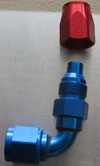Anodising
 Aluminium offers many benefits to mechanical engineering designers, and racing engine designers have long been keen to exploit its low density and good strength. There are now aluminium alloys commercially available with tensile strengths well above 700 MPa (>100 ksi) and the development of alloys for specific properties has accelerated in recent years.
Aluminium offers many benefits to mechanical engineering designers, and racing engine designers have long been keen to exploit its low density and good strength. There are now aluminium alloys commercially available with tensile strengths well above 700 MPa (>100 ksi) and the development of alloys for specific properties has accelerated in recent years.
One disadvantage with aluminium, however, is its propensity to oxidise - anyone who has left their motorcycle outside in a British winter, for example, will attest to this. And take a look underneath a relatively new car driven in winter and it will not be a pretty sight once plastic covers are removed. So in this article I will look at anodising aluminium, specifically the thin anodic coatings used primarily to protect against environmental oxidation and provide a decorative coating. I will cover the process known as hard anodising in a later article.
Anodising is a process whereby a component's surface is deliberately oxidised under controlled conditions, converting the surface layer to a film of aluminium oxide (alumina). The aluminium parts are used as an anode in an electric circuit, with an acid bath as the electrolyte. There are variations on this basic process using different acids, but the same principles apply.
The two common anodising types are based on solutions of chromic acid and sulphuric acid. Chromic acid has been in use for longer, but pressure is growing to phase it out because of environmental concerns about the use of hexavalent chromium in industrial processes, and it is felt to be harder to dye these films to produce attractive coloured surfaces.
Anodising using sulphuric acid is a new process, and requires more careful control of processing parameters such as voltage and electrolyte temperature. This type of anodising is more suited to being dyed, and a wide range of colours is available. Because sulphuric acid anodising is not a subject of environmental concerns, more development is going into this process, with the sulphuric acid being combined with other acids to produce better results.
The choice of which type of anodising is used can affect the fatigue performance of the anodised part. While a general rule of thumb is that thicker films will degrade fatigue strength to a greater extent, we need to take account of the type of anodising used.
For example, Augros et al* show that, for 7050 alloy, samples undergoing chromic acid anodising at a thickness of 1-3 microns (1 micron = 0.000039 in) have a lower fatigue strength than identical samples with a sulphuric acid anodised film thickness of 10-12 microns. The authors also present data showing the positive effect on fatigue when citric acid is added to the sulphuric process.
The fatigue effect for different alloys also varies greatly. Compared with untreated alloys, the Augros paper reports a 2.5% loss of fatigue strength on 2214 alloy when anodised using chromic acid and with a 5-6 micron film, but a similar film of chromic acid anodising on 7050 alloy causes a 43% loss of fatigue strength.
When specifying anodising, it is good practice to consult the anodiser, and ensure they know which grade of aluminium is being used. Not all alloys give the same results, and processing parameters may need to be changed depending on the material.
* M. Augros et al: Innovative Cr-free anodizing & sealing processes for corrosion protection of aerospace aluminium alloys, presented at Surfair 2006
Fig. 1 - Hose ends and fittings are commonly finished with a coloured anodic film
Written by Wayne Ward